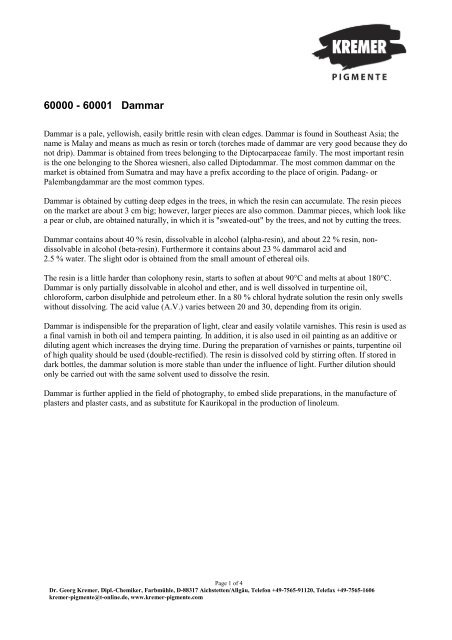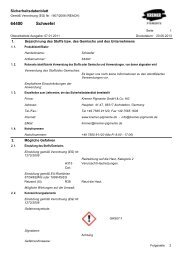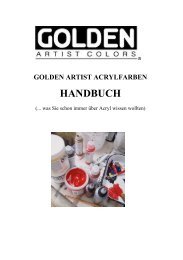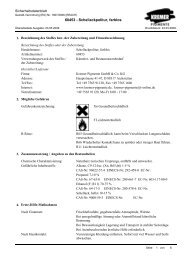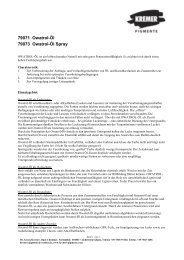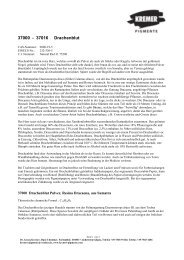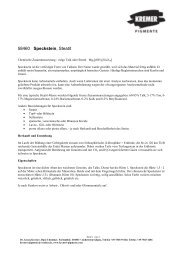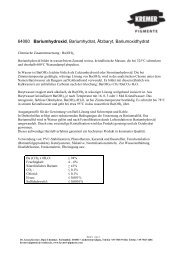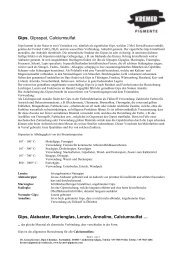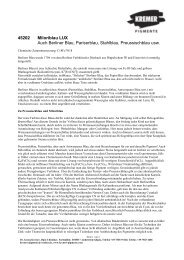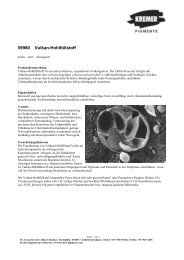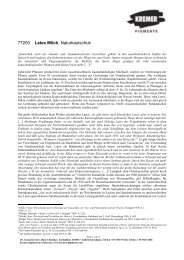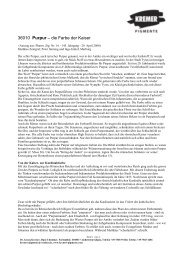60000 - 60001 Dammar - Kremer Pigmente
60000 - 60001 Dammar - Kremer Pigmente
60000 - 60001 Dammar - Kremer Pigmente
You also want an ePaper? Increase the reach of your titles
YUMPU automatically turns print PDFs into web optimized ePapers that Google loves.
<strong>60000</strong> - <strong>60001</strong> <strong>Dammar</strong><br />
<strong>Dammar</strong> is a pale, yellowish, easily brittle resin with clean edges. <strong>Dammar</strong> is found in Southeast Asia; the<br />
name is Malay and means as much as resin or torch (torches made of dammar are very good because they do<br />
not drip). <strong>Dammar</strong> is obtained from trees belonging to the Diptocarpaceae family. The most important resin<br />
is the one belonging to the Shorea wiesneri, also called Diptodammar. The most common dammar on the<br />
market is obtained from Sumatra and may have a prefix according to the place of origin. Padang- or<br />
Palembangdammar are the most common types.<br />
<strong>Dammar</strong> is obtained by cutting deep edges in the trees, in which the resin can accumulate. The resin pieces<br />
on the market are about 3 cm big; however, larger pieces are also common. <strong>Dammar</strong> pieces, which look like<br />
a pear or club, are obtained naturally, in which it is "sweated-out" by the trees, and not by cutting the trees.<br />
<strong>Dammar</strong> contains about 40 % resin, dissolvable in alcohol (alpha-resin), and about 22 % resin, nondissolvable<br />
in alcohol (beta-resin). Furthermore it contains about 23 % dammarol acid and<br />
2.5 % water. The slight odor is obtained from the small amount of ethereal oils.<br />
The resin is a little harder than colophony resin, starts to soften at about 90°C and melts at about 180°C.<br />
<strong>Dammar</strong> is only partially dissolvable in alcohol and ether, and is well dissolved in turpentine oil,<br />
chloroform, carbon disulphide and petroleum ether. In a 80 % chloral hydrate solution the resin only swells<br />
without dissolving. The acid value (A.V.) varies between 20 and 30, depending from its origin.<br />
<strong>Dammar</strong> is indispensible for the preparation of light, clear and easily volatile varnishes. This resin is used as<br />
a final varnish in both oil and tempera painting. In addition, it is also used in oil painting as an additive or<br />
diluting agent which increases the drying time. During the preparation of varnishes or paints, turpentine oil<br />
of high quality should be used (double-rectified). The resin is dissolved cold by stirring often. If stored in<br />
dark bottles, the dammar solution is more stable than under the influence of light. Further dilution should<br />
only be carried out with the same solvent used to dissolve the resin.<br />
<strong>Dammar</strong> is further applied in the field of photography, to embed slide preparations, in the manufacture of<br />
plasters and plaster casts, and as substitute for Kaurikopal in the production of linoleum.<br />
Page 1 of 4<br />
Dr. Georg <strong>Kremer</strong>, Dipl.-Chemiker, Farbmühle, D-88317 Aichstetten/Allgäu, Telefon +49-7565-91120, Telefax +49-7565-1606<br />
kremer-pigmente@t-online.de, www.kremer-pigmente.com
CERTIFICATE OF ANALYSIS<br />
Product: <strong>60000</strong> <strong>Dammar</strong> I A (white, clean, selected quality)<br />
Product: <strong>60001</strong> <strong>Dammar</strong>, grains and powder (may contain impurities)<br />
Parameter Method Result<br />
Acid value: ASTM D. 465-82-1987 31.8<br />
Melting temperature: ASTM D. 87-1987 78.0°C<br />
Volatile components: Dry at 105°C 0.7 %<br />
Iodine number: AOCS 70.8<br />
Flash point: ASTM D. 92 210°C<br />
Ashes: ASTM D. 1063-51-1987 0.01 %<br />
Color index (Gardner): ASTM D. 1544-1980 < 0.5 %<br />
Page 2 of 4<br />
Dr. Georg <strong>Kremer</strong>, Dipl.-Chemiker, Farbmühle, D-88317 Aichstetten/Allgäu, Telefon +49-7565-91120, Telefax +49-7565-1606<br />
kremer-pigmente@t-online.de, www.kremer-pigmente.com
The Jakarta Post – March / April 2008<br />
Krui people preserve environment their own way<br />
(Oyos Saroso H.N. – The Jakarta Post, Krui, West Lamping)<br />
The sun was just beginning to set when a man in his 30s climbed a Damar pine, carrying a rattan basket on<br />
his shoulder. He climbed quickly, with a rattan rope, while carefully checking every cut on the tree for sap.<br />
On finding the thickened, dried sap, he would collect it and put pieces into his basket.<br />
Such sights are common in Pahmungan village, Krui, Lampung.<br />
For the people of Krui, collecting resin is not just a job for men but women also. The Damar pine (Shorea<br />
javanica) has been cultivated in Krui since hundreds of years ago.<br />
The area’s natural tree resin has been well known abroad for a long time. Dutch rulers used it as raw<br />
material to produce various products like varnish, paint, ink, incense and cosmetics.<br />
Until now, the people of Krui continue protecting their legacy amidst flourishing new rice fields and<br />
plantations. Green Damar pines fill the hills and farms in the coastal area.<br />
The Krui people, who call Damar plantations repong damar, have customary law to protect the pines.<br />
The pine cannot be cut and any person who violates the law receives punishment in the form of planting new<br />
Damar trees. Even would-be bride and grooms must plant trees before getting married.<br />
Some Krui people even believe they can talk to the Damar pine. For many years, parents have told their<br />
children, “if you need to pay for your childrens’ school fees, talk to Damar trees”.<br />
Lampung cultural observer Anshori Djausal said the custom has no denotative meaning.<br />
“It’s actually a message for Krui children to continue protecting Damar trees, and it has been successful –<br />
many Krui people have become successful and have attained high levels of education since their parents<br />
cultivated Damar pines”, he said.<br />
The trees are the main source of income for the people of Krui.<br />
Each week, farmers collect the sap and when they have enough, they sell it to collectors.<br />
Threats are looming from the opening of palm oil plantations, which have loosened the customary law. In<br />
the late 1980s, many Damar trees were cut down for palm oil plantations, and illegal loggers who used the<br />
pines to cover up stolen logs. The police would not stop them because they would not realize the loggers had<br />
mixed illegal logs with Damar pine logs.<br />
Villagers in Pahmungan village, however, have remained true to their tradition of protecting the pines.<br />
Dozens of other villages in West Lampung still uphold a similar tradition.<br />
Husin, a 57-year-old resident Pahmungan, nurtures Damar trees on his plantation, which he inherited from<br />
his ancestors who have owned them ever since the Dutch rule.<br />
He said plantations were usually left to the eldest child. The child who received the land should begin a new<br />
Damar plantation.<br />
“The more repong damar one has, the higher his social status becomes,” Husin said.<br />
According data from West Lampung regency administration, there are currently some 17,500 hectares of<br />
repong damar in the regency, mainly in coastal areas, with some 1,7 million trees.<br />
The trees, which are mainly grown by villagers, produce around 315 tons of resin annually, which is largely<br />
exported to Bangladesh, India, Italy, Pakistan and Saudi Arabia.<br />
Page 3 of 4<br />
Dr. Georg <strong>Kremer</strong>, Dipl.-Chemiker, Farbmühle, D-88317 Aichstetten/Allgäu, Telefon +49-7565-91120, Telefax +49-7565-1606<br />
kremer-pigmente@t-online.de, www.kremer-pigmente.com
The Krui people do not fill their plantations with pines alone but interplant them with fruit trees like durian<br />
and others.<br />
Environmental activist Kurniadi, who works with repong damar farmers, said that ecologically, the<br />
traditional Damar pine farming existence has a high value. Besides serving as a water catchment area,<br />
repong damar also serves as a buffer zone for conservation efforts at Bukit Barisan Selatan National Park.<br />
The government awarded the people of Krui with the Kalpataru, in 1997, for their commitment to the<br />
preservation of Damar pines through their customary law.<br />
Kurniadi said that for Krui people, repong damar is more than just a source of income.<br />
“There’s a strong bond between Krui people and repong damar. It is their identity,” he said.<br />
Environmental activists and researchers, hold repong damar in Krui is an example of harmony between<br />
humans and nature. Preserving repong damar is not easy for the Krui people. Some have been tempted to sell<br />
plantations to earn money to hold parties or buy modern appliances.<br />
Zulfaldi, one of executives of the Repong Damar Owners Community Association, said that without<br />
supervision, repong damar may vanish.<br />
“The arrival of modern culture, like it or not, has tempted young people in Krui to work in big cities and<br />
industry and leave repong damar,” Zulfaldi said.<br />
“He said the association was working with a research institution to improve the Damar quality to help boost<br />
its price.<br />
“We’re trying to raise the selling price of Damar resin with a process which can refine low quality sap,” he<br />
said.<br />
A survey conducted in 2004 by the Center of International Forestry Research showed that with a selling<br />
price of around Rp 4,000 per kg, Damar farmers can earn approximately Rp 10 million a year. The amount<br />
excludes harvests from other trees grown among Damar plantations.<br />
Harvesting repong damar can provide a relatively good income.<br />
Alipin Nur, a 63-year-old Damar farmer in Pahmungan, said prices were once much higher. In 1998,<br />
<strong>Dammar</strong> sap could reach Rp 8,000 a kg.<br />
Ideally, he said, considering production costs, the price should be at least Rp 15,000 a kg.<br />
“Back then, a kilogram of Damar could buy three kilograms of rice, but now Damar prices are even less than<br />
rice.”<br />
Page 4 of 4<br />
Dr. Georg <strong>Kremer</strong>, Dipl.-Chemiker, Farbmühle, D-88317 Aichstetten/Allgäu, Telefon +49-7565-91120, Telefax +49-7565-1606<br />
kremer-pigmente@t-online.de, www.kremer-pigmente.com


